Class 10 Science Chapter 9 Question Answers - Light Reflection and Refraction
Q1: Which one of the following materials cannot be used to make a lens?
(a) Water
(b) Glass
(c) Plastic
(d) Clay
Ans: (d) Clay
Explanation: Clay is not transparent, so it cannot be used to make lenses that focus light. Materials like water, glass, and plastic are transparent and can be shaped into lenses.
Q2: The image formed by a concave mirror is observed to be virtual, erect and larger than the object. Where should be the position of the object?
(a) Between the principal focus and the centre of Curvature
(b) At the centre of curvature
(c) Beyond the centre of curvature
(d) Between the pole of the mirror and Its principal focus.
Ans: (d) Between the pole of the mirror and its principal focus.
Explanation: When an object is placed between the pole and the focus of a concave mirror, the image formed is virtual, erect, and magnified (larger than the object).
Q3: Where should an object b. placed In front of a convex lens to get a real
image of the size of the object?
(a) At the principal focus of the lens
(b) At twice the focal length
(c) At infinity
(d) Between the optical centre of the lens and its principal focus
Ans: (b) At twice the focal length.
Explanation: For a convex lens, placing the object at twice the focal length (2f) will produce a real image that is the same size as the object.
Q4: A spherical mirror and a thin spherical lens have each a focal length of 15 cm. The mirror and the lens are likely to be:
(a) both concave
(b) both convex
(c) the mirror is concave, but the lens is convex
(d) the mirror is convex, but the lens is concave
Ans: (b) Both convex
Explanation: A spherical mirror and a thin spherical lens each have a focal length of 15 cm. Let's break it down:
- A concave mirror has a negative focal length.
- A convex mirror has a positive focal length.
- A concave lens has a negative focal length.
- A convex lens has a positive focal length.
Since the focal length is positive in this case (15 cm), both the mirror and the lens are likely to be convex.
So, the correct option is:
(b) both convex.
Q5: No matter how far you stand from a mirror, your image appears erect. The
mirror is likely to be
(a) plane
(b) concave
(c) convex
(d) Either plane or convex
Ans: (d) Either plane or convex.
Explanation: Plane mirrors and convex mirrors both produce virtual, erect images regardless of the distance from the mirror. Concave mirrors typically form inverted images unless the object is within the focal length.
Q6: Which of the following lenses would you prefer to use while reading small letters found in a dictionary?
(a) A convex lens of focal length 50 cm
(b) A concave lens of focal length 50 cm
(c) A convex lens of focal length 5 cm
(d) A concave lens of focal length 5 cm.
Ans: (c) A convex lens of focal length 5 cm.
Explanation: A convex lens with a short focal length (5 cm) provides greater magnification, which is helpful when reading small letters in a dictionary.
Q7: We wish to obtain an erect image of an object, using a concave mirror of focal length 15 cm. what should be the range of distance of the object from
the mirror? What is the nature of the image? Is the image larger or smaller than the object? Draw a ray diagram to show the image formation in this case.
Ans: We are given the focal length of the concave mirror as f = -15 cm.
For getting an erect image using a concave mirror, the object should be placed at a distance less than the focal length. i.e. 15 cm from the pole. The image formed will be virtual, enlarged and erect.
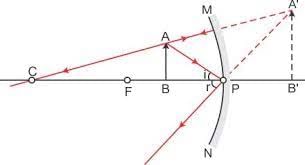 Image formation when the object is placed between focus and pole of a concave mirror.
Image formation when the object is placed between focus and pole of a concave mirror.
Q8: Name the type of mirror used in the following situations.
(a) Headlights of a car
(b) Side/rear-view mirror of a vehicle
(c) Solar furnace
Support your answer with reason.
Ans: (a) Concave mirror, to get powerful and parallel beams of light.
(b) Convex mirror because it always gives an erect image and enables the driver to view much larger area.
(c) Concave or parabolic mirror because it can concentrate sunlight at the focus to produce heat in the solar furnace.
Q9: One half of a convex lens is covered with a black paper. Will this lens produce a complete image of the object? Verify your answer experimentally. Explain your observations.
Ans: Yes, even when one half of the lens is covered with a black paper, complete image of the object will be formed. Take a convex lens and focus the light from a distant object onto a screen. As expected an image (sharp) is formed at a distance equal to the focal length Cover the lower or the upper half of the lens and focus the light from the same object onto the same screen. You will be able to get a sharp image again; however the brightness of the image will be less in the second case. The same effect w,ll be seen even if the lens is half covered with black strips.
Q10: An object 5 cm in length is held 25 cm away from a converging lens of focal length 10 cm. Draw a ray diagram and find the position, size and the nature of the image formed.
Ans: 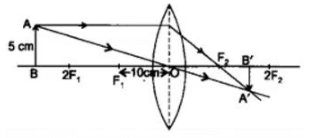
Using lens formula, we have
1f = 1v - 1u
110 = 1v + 1(-25)
⇒ 110 - 125 = 1v
⇒ 15250 = 1v
⇒ v = 25015 = 16.66 cm
m = vu = hh'
50/3(-25) = h5
⇒ h = -103 = -3.33 cm
Therefore, the image is formed between F2 and 2F2 on the other side of the lens. It is real and inverted, and smaller in size than the object.
Q11: A concave lens of focal length 15 cm forms an image 10 cm from the lens. How far is the object placed from the Lens? Draw the ray diagram.
Ans:
f = -15 cm, v = -10 cm
Using lens formula, we have:
1f = 1v - 1u
⇒ 1u = 1v - 1f
⇒ 1u = 1-10 - 1-15
⇒ 1u = -5150
⇒ u = -1505 = -30 cm
Therefore the object is placed at 30 cm from the lens. The ray diagram is given as follows:
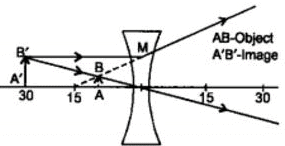
Q12: An object is placed at a distance of 10 cm from a convex mirror of focal length 15 cm. Find the position and nature of the image.
Ans: f = +15 cm. u = -1o cm
For mirror, we have
1f = 1u + 1v
1v = 1f - 1u
⇒ 1v = 115 - 1-10
⇒ 1v = 10 + 15150
⇒ 1v = 25150
⇒ v = 15025 = 6 cm
The image must be virtual, diminished and erect.
Q13: The magnification produced by a plane mirror is +1. What does this mean?
Answer: This means that size of the image is equal to the size of the object.
Q14: An object 5.0 cm in length is placed at a distance of 20 cm in front of a convex mirror of radius of curvature 30 cm. Find the position of the image nature and size.
Ans: 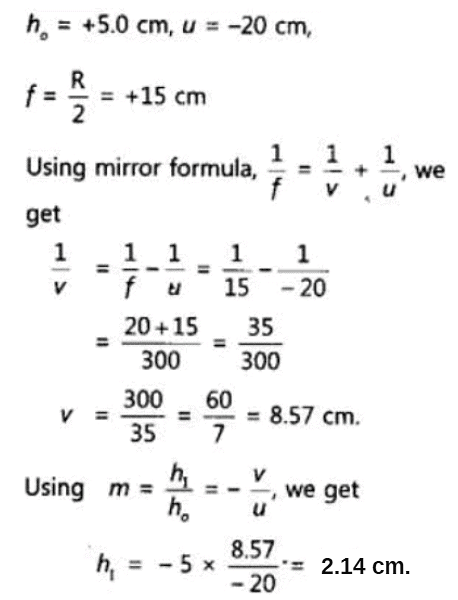
Since v is +ve the image is virtual. Since h1 = 2.14 cm < 5.0 cm, the image is diminished.
Q15: An object of size 7.0 cm is placed at 27 cm in front of a concave mirror of focal length 18 cm. At what distance from the mirror should a screen be placed, so that a sharp focused image can be obtained? Find the size and the nature of the image.
Ans: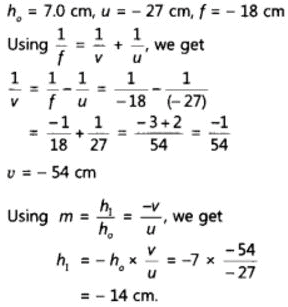
Since h1 > h0 the image is enlarged. As the value of h1 is -ve, the image is inverted. Since v is -ve, the image is real.
Q16: Find the focal length of a lens of power -2.0 D. What type of lens is this?
Ans:
We know that
f = 1P
⇒ f = -12 m
⇒ f = -1002 cm = -50 cm
As the Focal length of lens is -ve, it will be a concave lens.
Q17: A doctor has prescribed a corrective lens of power +1.5 D. find the focal length of the lens. Is the prescribed lens diverging or converging?
Ans:
P = +1.5 D
f = 100P cm = 1001.5 = 66.67 cm = 0.67 m
As the focal length is +ve it is convex lens. Hence, it is a converging lens.
|
80 videos|569 docs|80 tests
|
FAQs on Class 10 Science Chapter 9 Question Answers - Light Reflection and Refraction
| 1. What is the law of reflection in relation to light? |  |
| 2. How does refraction occur when light passes through different mediums? |  |
| 3. What are some common applications of reflection and refraction in everyday life? |  |
| 4. What is total internal reflection and how does it differ from regular reflection? |  |
| 5. How do the properties of light change as it reflects or refracts? |  |






















